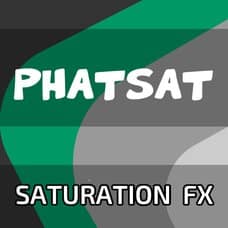
These days, saturation typically refers to analogue-style distortion effects. The technology of saturation combines tape-style distortion with multiband compression and limiting. The PhatSat saturation effect can be used for warming up individual instrument tracks or applied to the whole mix to make it sound better. Saturation is very usable with any kind of sound source or instrument.
Try this PHATSAT Saturation Rack Extension in your Reason rack today!
Product details
Many musicians like to use analog-like warm saturation effects.
The term “saturation” comes from the level of magnetism of analog magnetic tape. When recording to tape, you could get distortion from the tape by adding more magnetism. When making recordings with this method, you could easily overload the signal. Every tape device had a magnetic capacity limit. When the limiter was overloaded, you got a characteristic called saturation.
There are two main types of saturation – tube saturation and tape saturation. Tape saturation adds a low and high level distortion to the signal, and is a great way to add punch to your kick and snare. It also works beautifully with vocals. Saturation on guitars can work like a slight Boost/Over/Fuzz/Distortion. Using saturation on Bass is an alternative way to bass-amp or bass-compress the audio to warm up the track.
Now you should know that saturation effects use harmonic distortion, compression and limiting to alter the sound. The PHATSAT’s drive also has individual distortion controls for Low and High frequencies.
Why did we call this saturation effect PHATSAT? With the Density parameter you can run multiple stages of distortion to fatten the tone.
PHATSAT Parameters
MAIN DRIVE: Level of drive/distortion (tape magnetism)
LOW DRIVE: Level of drive/distortion for Low frequencies
HIGH DRIVE: Level of drive/distortion for High frequencies
KILL HIGH: Kill High frequencies. Help to remove clips / add new colors to processed signal
DENSITY: Level of antisaturation or smoothness of saturation.
Negative values (unsaturate): get a thinned out tone that drops out.
Positive values (saturate): run multiple stages to fatten the tone
THRESHOLD: Audio level above which compression/limiting is applied.
BLENDER: Mix of incoming and processed signal
Soft Bypass / In-Out Corrections
ACT / SOFT BYP: Enable / Bypass PhatSat effect. Soft bypass variant
INPUT: Amp gain correction of the dry input level (unprocessed input signal) before it goes to the BLENDER (Dry/Wet) control
OUTPUT: Amp gain correction of the output level of the processed signal after it leaves the BLENDER (Dry/Wet) control
CV INPUTS Use these CV inputs to control the main parameters with external CV source curves.